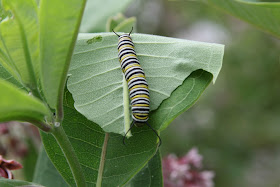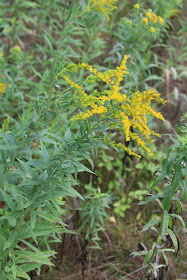That is okay.
These are spaces designed to be habitats and outdoor classrooms. They are not formal or even informal gardens where everything must be in its perfect place, because the "perfect" place for a plant to my eyes might not where the plant ultimately wants to be. The gardens are planted with a plan that they will evolve and change, whether I want them to or not. In the long run, I think they function better in their role as a habitat if they are allowed to make those changes. Perhaps it would be better if I didn't refer to these spaces as gardens, but rather as habitats. After all very little gardening takes place in the spaces.
Despite my general hands-off policy toward these habitats, they do require occasional maintenance. For instance, when school is in session each of these habitats has a path so students can access the interior. This path often becomes overgrown and must be cleared. This might mean moving (or removing) some plants that have self-sown or it could even mean trimming a few plants that exhibit especially vigorous growth.
When planting these space, I always plan for a buffer space around the edge so plants are not flopping over onto lawns, sidewalks, etc.. When plants self-sow, they often fill this blank space taking advantage of the lack of competition. Some of these plants may also need to be removed if they are too tall for the space.
Weeds. Every garden/habitat will eventually get its weeds. They might sprout from wind-borne seeds, or an animal may have deposited them, or they may have been lying dormant in a seed bank buried in the ground. Regardless of their origin, they appear. When I find a plant in one of the schoolyard habitats that was not planted there I evaluate it in three steps:
- Is it a tree or shrub seedling? If the answer is yes it is removed immediately - all woody plants that have not been deliberately planted are removed as soon as they are noticed. If the plant is not a tree or shrub, go on to step 2.
- Is the plant native or non-native? If it is a non-native plant, it goes immediately. I know that many non-native plants have a great deal of value in habitats, but most do not. These gardens/habitats are meant to be filled with native plants to serve as habitat for native pollinators. If you want to attract native insects have their native host plants and nectar plants available to them. Non-native plants are not welcome at all in my schoolyard habitats. For native plants, go on to step 3.
- Is the plant growing in a pathway or right on the edge of the habitat? If it is and can be easily moved, it will find a new home in the habitat. If it can't be easily moved, it unfortunately goes bye-bye. If it is not right on the edge or in the middle of the path, then the response that it gets is "You're free to grow. Welcome to the party."
To the gardens! From youngest to oldest.
Mount Pleasant Discovery Museum
This space was planted on June 26th this year. The space was initially lawn on top of clay soil, with next to no topsoil. The plants used here were leftovers from the next garden, with the exception of a few larger plants transplanted from the oldest habitat. Every plant (except the transplants) in this space cam from either a 2" plug or a 2" pot. This meant that they were small plants with a small root system. They had one job this summer - stay alive. Because they were planted so late in the year, the staff at the Discovery Museum was watering these plants regularly to get them through our rather dry months of July and August. Next year is when we shall see what this space can look like. The plants in this space were intermingled throughout the space with the idea that it would look more like a small piece of a natural meadow when mature, rather than a planned garden.
Morey Public School Academy
This garden was planted on June 4th this year. Like the above garden at the Mt. Pleasant Discovery Museum, all plants were small plants from 2" pots or 2" plug flats. Before this garden was installed, this space was also bare lawn over clay soil with almost no topsoil. These plants were laid out in more of a planned pattern than the above garden - every square yard had up to 5 plants of the same species planted in it, with several adjoining squares planted with the same species.
The plants here were regularly watered for about 2 weeks but have been on their own since then - the clay soil and a thick layer of mulch retains any water that they get very well. Like the space at the museum, the only job for these plants this summer was to stay alive. Some of them have managed to grow quite well and send out blooms. Most of them are focusing on developing roots that may reach down 15 feet for some species.
Winn Elementary
This garden/habitat was planted on June 5th 2012. It is currently in its second year of growth. Every plant in this space was originally in a 2" pot. This space has several challenges. Again it has clay soil with almost no topsoil. Also when a heavy rain occurs, hundreds of gallons of water come off the roof and wash over this space, moving the wood mulch around - resulting in some areas with bare soil and other spaces with 6 inches of mulch. The growth of the plants this year has alleviated this problem to some degree, but the mulch still moves. One nice benefit of the clay soil is that with the mulch moisture is retained very well.
This garden was plotted out much like the one above with clusters of 2-4 plants of a species intermingled with clusters of plants of other species. Having several plants of any given species located close to each other ensures better cross-pollination by insects. Unlike all of the other gardens/habitats, this one is not surrounded on all four sides by buildings or sidewalks. The west side is bordered by the front lawn of the school. When this garden was planned, we put in a sweeping curved edge that incorporated two existing ornamental crabapple trees into the garden. The asters around the crabapple closest to the school entrance have decided to live up to their species' potential and actually look too large in their space - these plants will be moved next spring to a different location in the garden. The school principal recently told me that since the garden was put in place that teachers and students are using the front of the school for the first time ever.
Saginaw Chippewa Academy
This is the oldest of the four gardens/habitats, having been planted in June 2011. It is in its summer of growth. It is the smallest space of the four, being only only 16ft deep by 36ft wide, but it has the best soil - there is a thick rich layer of loam here with lots of organic matter. This space also receives lots of runoff from the roof when it rains, especially the area near the stairs. The plants in this space were a mixture of 2" pots and quart containers. Plants in this space planted in clusters just like the 2 gardens above, with the taller plants generally placed nearer the building and shorter plants near the edges. Many of the plants here have vigorously self seeded and taken up some of the empty space.
All of the Common Milkweed in the habitat has spread from two transplanted plants. Common Milkweed will not stay where you want it, it spreads not only from seed but also by sending out long horizontal roots from which which clones of the original plant arise. Because of this tendency to grow where it wants, Common Milkweed looks "weedy" in a planned space. Milkweeds are the only host plants for the Monarch Butterfly. This garden is first and foremost a wildlife habitat and is certified as a Monarch Waystation - the Milkweed can grow where it wants.
As you can see from the photos, the pollinators very much like the pollinator garden. A special bonus for me, the presence of so many invertebrates in the garden has attracted the attention of tiger beetles. I noticed one of the fast running predators in the garden twice while I was weeding - unfortunately there were no pictures.























































+1.jpg)


